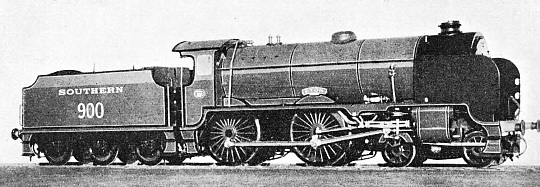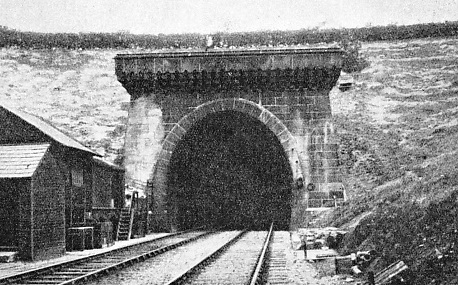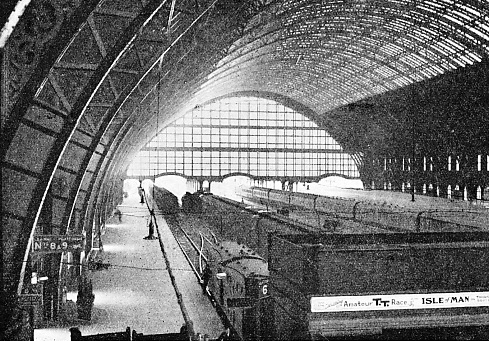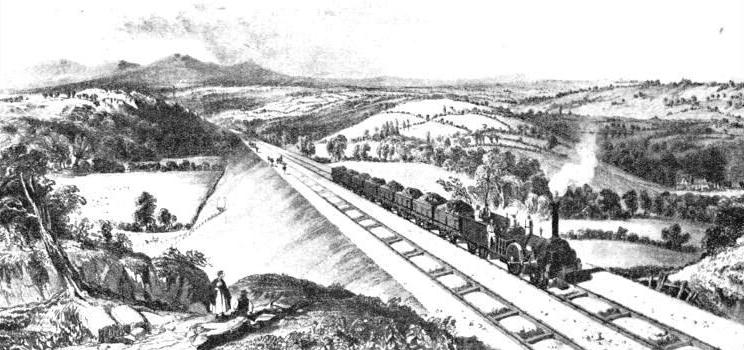
© Railway Wonders of the World 2012-


When Railways Were New
The Struggle Against Prejudice and Superstition
THE LICKEY INCLINE IN FORMER DAYS. The famous slope, with a gradient of 1 in 37.7, is now included in the Midland Division of the LMS Railway. It is situated near Bromsgrove, Worcestershire, on the route between Cheltenham and Birmingham.
THE first public railway was opened only a little over a 170 years ago, a trifling period in history. Yet it is difficult for us to-
If it is difficult for us to visualise a world without railways, it is also difficult to imagine the effect of their introduction on the public mind. The new method of transport met with a mixed reception. On the one hand, advocates were to be found among every section of the community, and even the smallest towns demanded -
A distinguished man of science “evoked the spectre at pleurisy that would certainly attack passengers when going through tunnels, always provided that they escaped the catastrophes resulting from the explosion of locomotive boilers”. And French doctors predicted that every conceivable disease would inevitably result from travelling by railway, since “the too rapid transition from one climate to another would have a deadly effect on the respiratory passages”, while “the brusque change of diet would give birth to dyspepsia or dysentery”.
The medical profession in England does not, on the whole, appear to have been so alarmist, except in relation to tunnels. One distinguished physician asserted that these “would expose healthy people to colds and consumption”, while another expressed his belief that “the deafening peal of thunder, the sudden immersion in gloom, and the clash of reverberated sounds in a confined space combine to produce a momentary shudder or idea of destruction, a thrill of annihilation”.
Doctors, however, only shared a popular prejudice of the time, and in 1837 it became necessary to ask two medical men, two surveyors, and a lecturer in chemistry to inspect the Primrose Hill Tunnel, London. Their verdict was that “although the cloud caused by the steam was visible near the roof, the air for many feet above our heads remained clear and apparently unaffected by steam or effluvia of any kind”. They were of opinion that the dangers incurred in passing through well-
Such an unqualified expression of opinion must have been welcome to many railwaymen, since there was a general belief, which died hard, that tunnels were unhealthy in the highest degree. This belief was fostered by the many people who, for reasons of their own, opposed individual railway schemes. When the second Bill promoted by the Great Western Railway was being discussed in Parliament, one of the arguments put forward by its opponents was that the Box Tunnel, by virtue of its length, would be dangerous. “Impracticable” and “monstrous” were other epithets that were used, and it took the combined forces of George Stephenson and Brunel to convince the House of Commons that there was no “likelihood of passengers being smothered by fumes from the engine”.
Tunnels apart, railways aroused in England a host of objections on moral and aesthetic grounds. That individual landowners should object to the construction of a line cutting right across a park, or interfering with the view from their windows, is intelligible. But to fear that a railway would undermine the discipline of a public school is another matter. That, however, was the view of the celebrated Dr. John Keate, a famous headmaster of Eton, who asked Mr. Gladstone to use his personal influence to prevent the construction of any railways serving Windsor.

ETON COLLEGE WAS HOSTILE to the suggestion of the railway. To-
The headmaster characterised these projects as “interfering with the discipline of the school, the studies and amusements of the boys, affecting the healthiness of the place, from the increase of floods, and endangering even the lives of boys”.
It is not quite clear why Dr. Keate should have thought that railways went hand-
Eton was, of course, not the only town to show hostility to the railway. The classic instance is that of Northampton, whose inhabitants successfully opposed the original scheme under which the London and Birmingham Railway was to provide them with a station. The line had to be diverted, and only a few years later “they humbly petitioned the company to build a branch line into their town”. If the original plan had been adhered to it would not have been necessary to build the costly Kilsby Tunnel, near Rugby. This has been described as undoubtedly the greatest engineering work on the London and Birmingham line. The original contract price was £99,000. but flooding, due to a quicksand that had been overlooked on the sinking of the trial shafts, compelled the contractor to abandon the work, which was afterwards finished by the railway company at a cost of about £300,000. Objection to railways has never had a costlier sequel.

KILSBY TUNNEL, near Rugby, the greatest engineering work on the London and Birmingham Railway. The tunnel, 2,400 yards long, and at an average depth of about 150 ft, cost over £300,000. The railway, now part of the LMS, was opened throughout in 1828.
Among the trials of the early railway promoters was the nature of the clauses often inserted in their Acts of Parliament, which were on occasion unworkable. Thus, one section of the Whitby and Pickering Railway Act provided that “It shall be lawful for the said Company and they are hereby empowered to provide locomotive Engines or other Power for the drawing or propelling of any Articles, Matters, etc, upon the said Railway”. But a little farther on in the same enactment it was stipulated that “It shall not be lawful for the said Company, or for any other Corporation or Person whatsoever, to use or employ locomotive Steam Engines upon the said Railway”.
This was not the only instance of the Whitby and Pickering being saddled with contradictory provisions. A section of a later Act permitted the company to charge for passenger journeys under five miles the fare applicable to a distance of five miles, but the next section raised the limit to six miles, “and, of course, with a copious amount of verbiage”.
Many other of the early railway Acts of Parliament sought to regulate details that have long since been left to the discretion of the companies themselves. For instance, it was provided in the original London and Birmingham Act that of the twenty-
Restrictions on the use of locomotives were common, although in most instances these were repealed before the opening of the lines concerned. The fourth Liverpool and Manchester Railway Act (which was the first that enabled the company “to enter the sacred precincts of Manchester”) included clauses “strictly forbidding the use of locomotives within Manchester or Salford, except on the lines as authorised”. Apparently there was a fear of the engines running loose on the streets like wild beasts.

MANCHESTER CENTRAL STATION TO-
The fact that this railway was not authorised to enter Manchester until it had secured four Acts of Parliament enables us to understand why the Parliamentary campaign should have cost £850 a mile. Even that figure is very far from being a record; in other instances the cost ran into thousands instead of hundreds of pounds a mile.
In no other country in the world has the cost of acquiring the land needed for railway construction been so high as in England. The London and Birmingham were obliged to pay some £320 an acre for purely agricultural land, and there is at least one recorded instance where a landowner’s opposition to a railway scheme was bought off by paying him £100,000 for an estate not worth a fraction of that sum. But the early railway promoters had to contend not only with landed , proprietors who charged extortionate prices, but also with those who would not have a railway at any price.
Sir Astley Cooper, surgeon to George the Fourth, could not be conciliated when it was proposed to take the London and Birmingham through his property at Berkhamsted. “You are proposing”, he told Robert Stephenson, “to cut up our estates in all directions for the purpose of making an unnecessary road. If this sort of thing be permitted to go on, you will in a very few years destroy the nobility”. When the same railway company’s Bill came before the House of Lords in 1832, after being passed by the Commons, it was thrown out, the Peers passing a resolution that “the directors had not made out a case which would warrant the forcing of the proposed railway through the lands and properties of distinguished landowners”.
Combating Vested Interests
The directors, who had originally calculated on spending a quarter of a million pounds on land and compensation. were thus forced to increase the figure to three times that amount before reintroducing the Bill in the following year, when. “with much of the previous opposition thus judiciously conciliated, it secured an almost bloodless victory”.
The early history of the Great Western Railway, or rather of its attempts to secure Parliamentary powers for construction, affords a particularly illuminating example of the manner in which our grandfathers regarded the railway.
This company’s first Bill underwent the bitterest opposition, the customary objections being reinforced by many ingenious, if ridiculous, arguments of a special nature. “It would poison the air. It would spoil the landscape. It would interfere with drainage. It would deprive the Thames of its traffic and cause the river to become choked”. And, as might have been expected, “it would corrupt the morals of Eton boys by giving them easy access to the dissipations of London”. More serious was the opposition both by coaching and landed interests; that of the former, is understandable enough, but it seems almost incredible to-
We may contrast the British attitude with that prevailing at the same time on the other side of the Atlantic, where small townships mortgaged themselves up to the hilt to provide funds for a railway that could be induced to enter their borders, and where such opposition as that of the people of Northampton would have been out of the question.
But the American railway pioneers and those who supported them had very different conditions for a background. Roads were few and bad; canals served only a fraction of the area of the United States; natural resources and manufactures had still to be developed; and the country supported only a small population. In all the circumstances, enthusiastic advocacy of railway schemes is as intelligible as is the reverse in the England of the same period.
Another characteristic of the early days of railways is the extent to “which ideas that we are inclined to regard as modern, or at least relatively so, were adopted during the quarter of a century after the opening of the Stockton and Darlington Railway. Eight-
You can read more on “The Atmospheric Railway”, “The Railway Mania” and “The Story of the Locomotive” on this website.
